On the Road is a weekday feature spotlighting reader photo submissions.
From the exotic to the familiar, whether you’re traveling or in your own backyard, we would love to see the world through your eyes.
It’s still summer in flyover country. Then we head to a national park with Mike in Oly, then we’re with Bill in Glendale after dark, and we finish with a 2-day trip to the North Island in New Zealand with Paul in St. Augustine.
Albatrossity
Week 2 of Summer in Flyover Country. Images of birds in flight, young birds and old birds, as well as some shots of birds in the middle of molting, a great summertime activity. Hope you enjoy them!
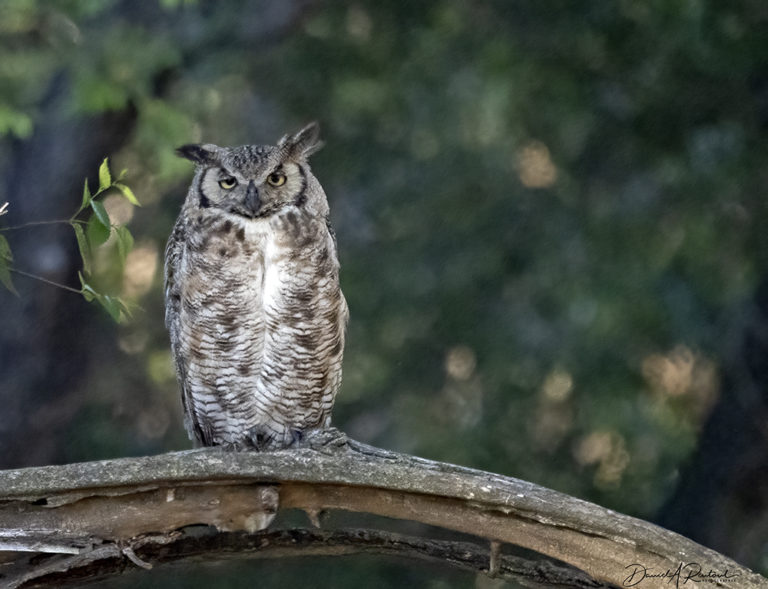
One last image from my trip to Quivira NWR; this Great Horned Owl (Bubo virginianus) seems to be sleepy-eyed and has a serious case of bed-head. Even owls have bad hair/feather days, I guess.
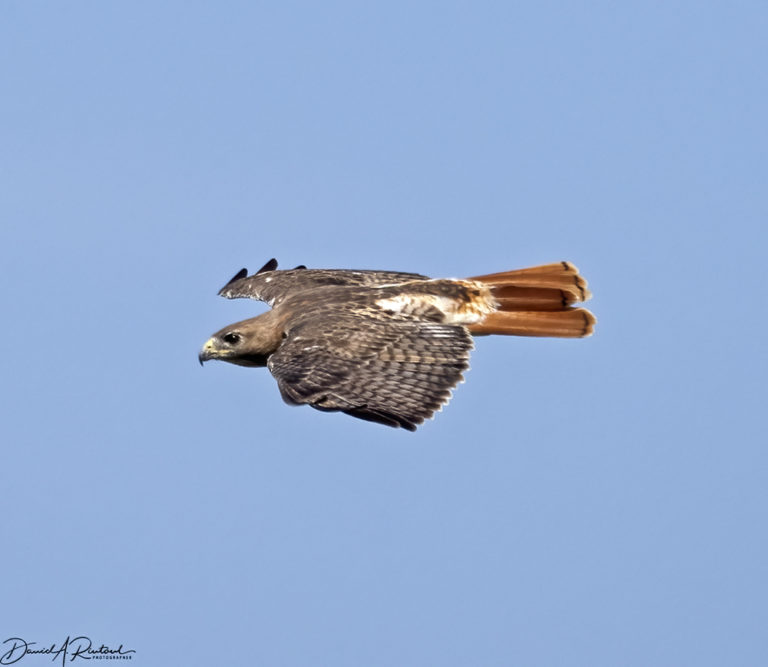
Red-tailed Hawks (Buteo jamaicensis) are mostly done raising young, and are now in heavy molt. This one is interesting because it demonstrates a couple of fun facts about feathers and molt. Those two darker and shorter feathers in the middle of the tail are replacing a couple that dropped out, and that pattern (loss and replacement) will continue from the middle outward on both sides until the entire tail is replaced. And the reason that they look darker is because the older feathers, which were new a year ago, have been bleached out by the sun.
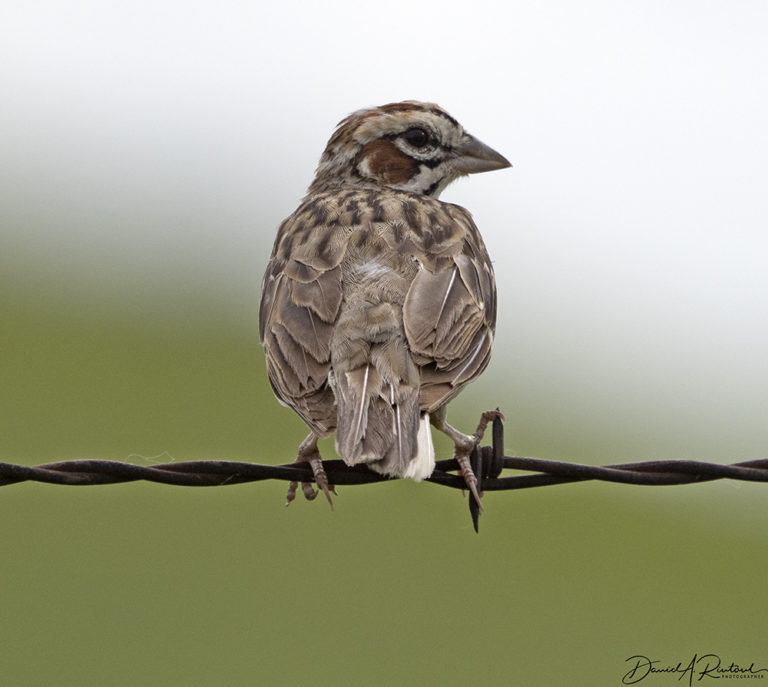
Another bird whose feathers are pretty beat up and need to be replaced. This is a Lark Sparrow (Chondestes grammacus), who will likely still have to wait a month or so before starting the molting process in earnest. Most of our sparrows have a complete molt before migrating south, fattening up on the fall seed crop while they grow those new feathers.
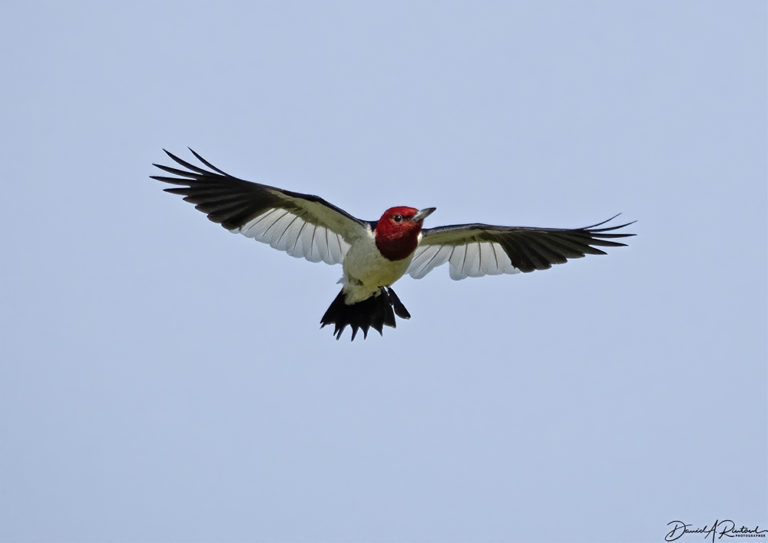
Here’s a bird which is common here in summer, rare in winter, and a highly sought rarity in much of the rest of the country. Red-headed Woodpeckers (Melanerpes erythrocephalus) hang out in our streamside gallery oak forests, but sometimes can be found well out in the treeless pastures, hawking insects from the air. This one was doing exactly that, and allowed me to get my first-ever in-flight photo of this iconic species.
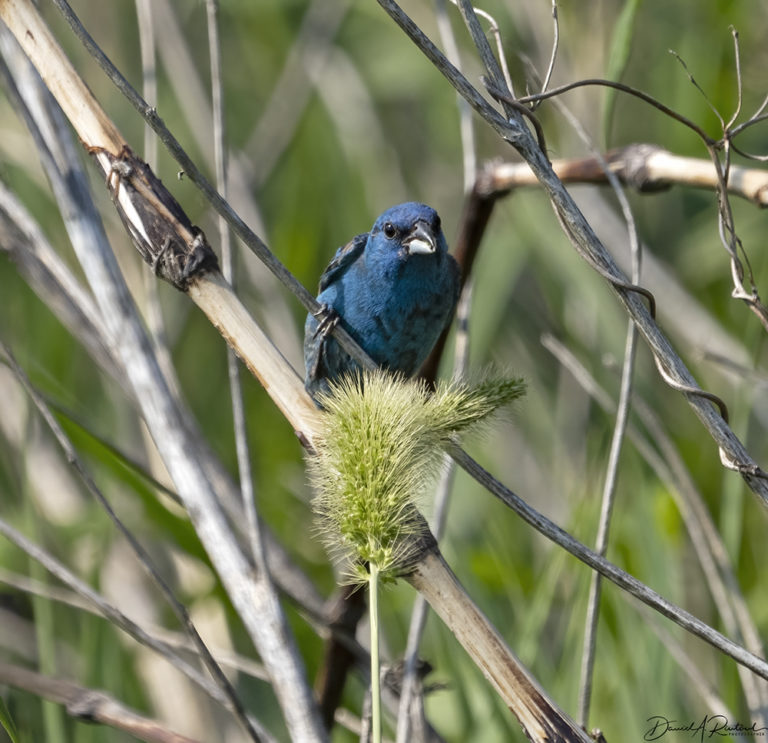
Indigo Buntings (Passerina cyanea) are also extremely common in my part of Flyover Country, and their cheery song can be heard just about anytime and anyplace at this time of year. This one was eating foxtail seeds, slowly but methodically, in a patch of dead sunflowers and live hemp.
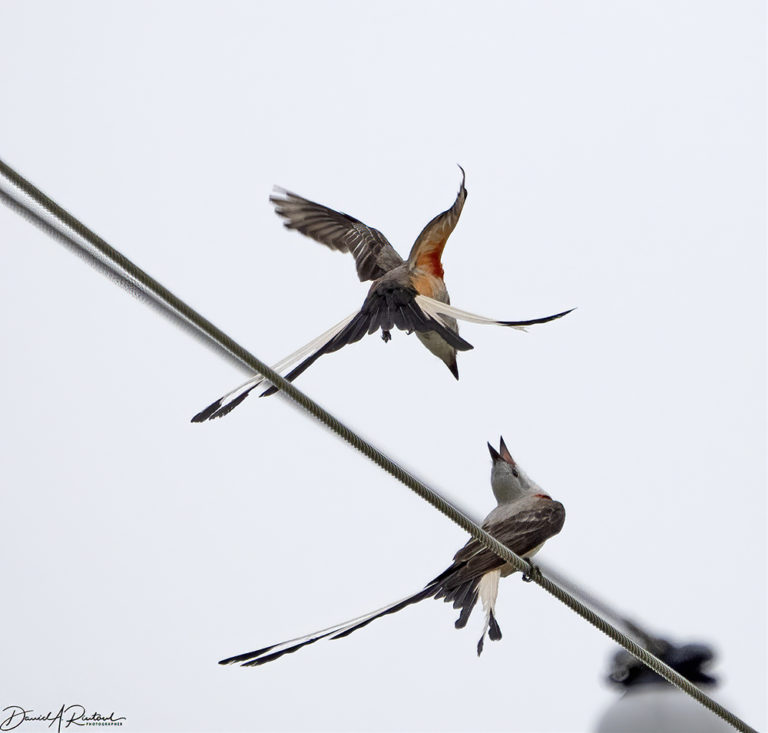
I didn’t actually plan this shot, but I hoped for it. I knew a spot where it seemed that the territories of two territorial Scissor-tailed Flycatchers (Tyrannus forficatus) met, and hoped to find them bickering and chasing each other so that I could get some action shots. They obliged, and these two males discussed property lines quite emphatically for several minutes a few minutes after I got there. I’m not sure that they settled anything, but the bird at the top seemed to get the last word on that day, as he chased the other one back into his own territory.
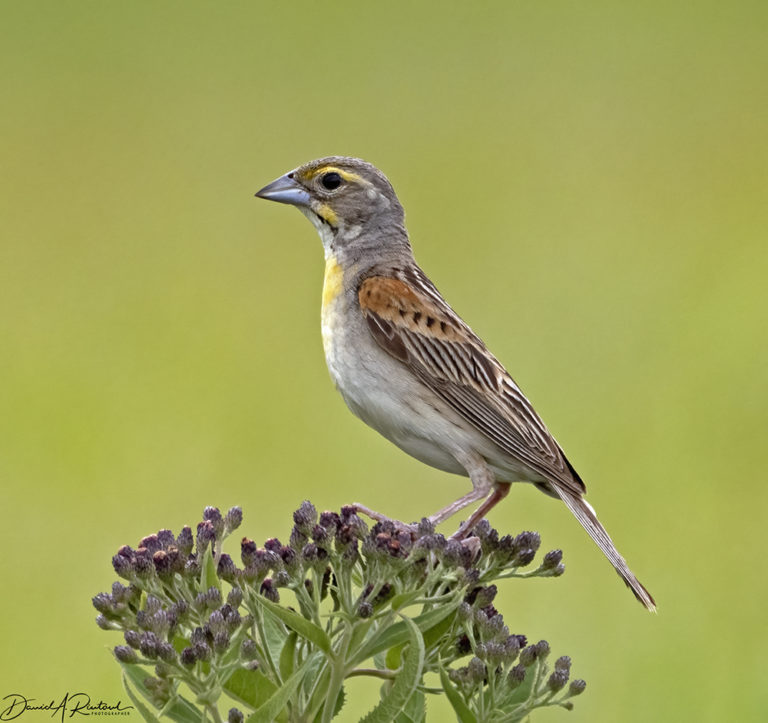
July means that the Ironweed (Vernonia fasciculata) is starting to bloom on our local prairies, and those sturdy blossoms are great perches for lots of prairie birds. Here’s a female Dickcissel (Spiza americana) taking a break from hauling insects to her babies in a nearby nest.
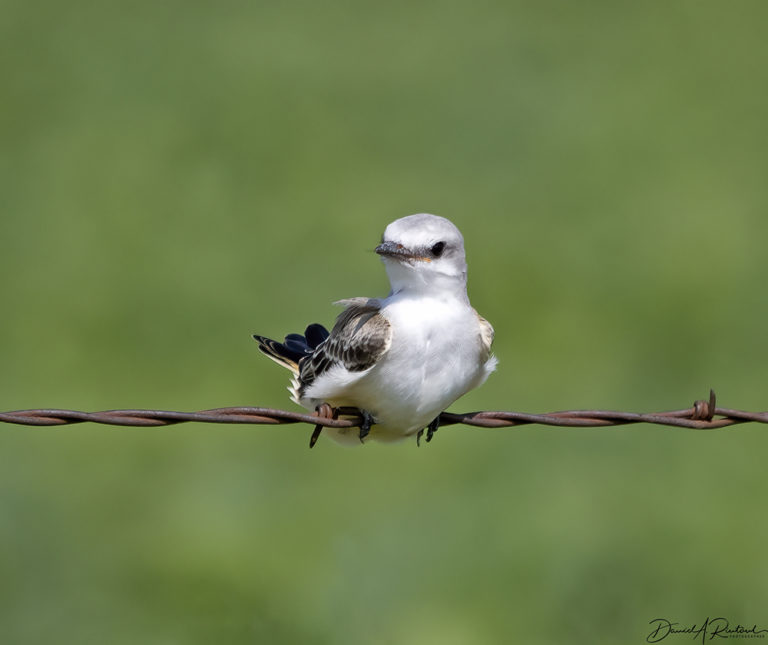
A Scissor-tailed Flycatcher, 2021 model year, hanging out waiting for mom or dad to bring it a tasty bug or two. It can certainly fly, it can probably forage but perhaps inefficiently, but it’s tail feathers are very short. I love the freshly-minted look of this bird!
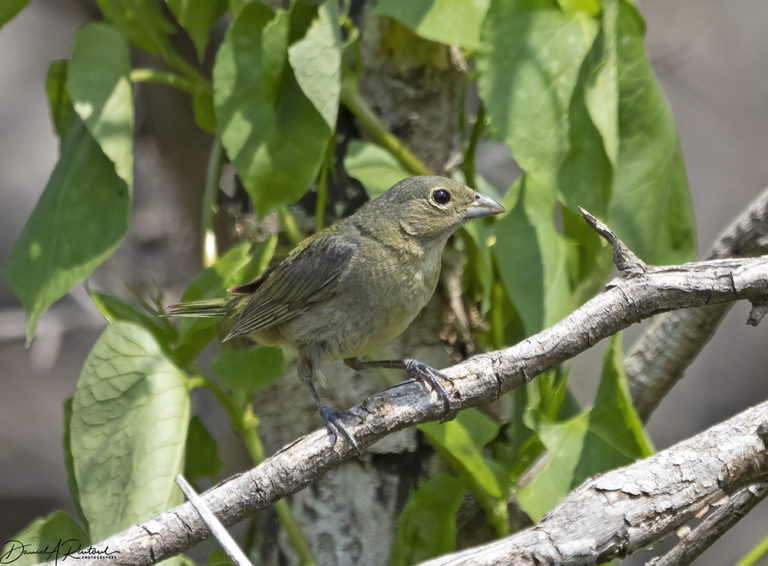
I’ve been hearing a lot of Painted Buntings (Passerina ciris) singing this summer, and this was one of those. Yes, it looks like a female Painted Bunting, but it was singing a pretty standard Painted Bunting song. Indeed, the singing attracted the attention of a male Indigo Bunting, who proceeded to chase it off.
According to the Birds of the World monograph for this species: “Males exhibit delayed plumage maturation and wear female-like plumage until the Second Basic Plumage is acquired during fall of their second calendar year. Prior to this, and after the First Prealternate Molt, about 40% of these second-year males can be distinguished from females in hand by occasional blue feathers on the head. These males are reproductively mature and often attempt to attract mates and breed. Thus, in the field these males are further distinguished from females during breeding season by behavior (males sing while females do not).”
It is possible that the Indigo Bunting was hoping to mate with this guy, who knows. The world is so confusing without the proper pronouns!
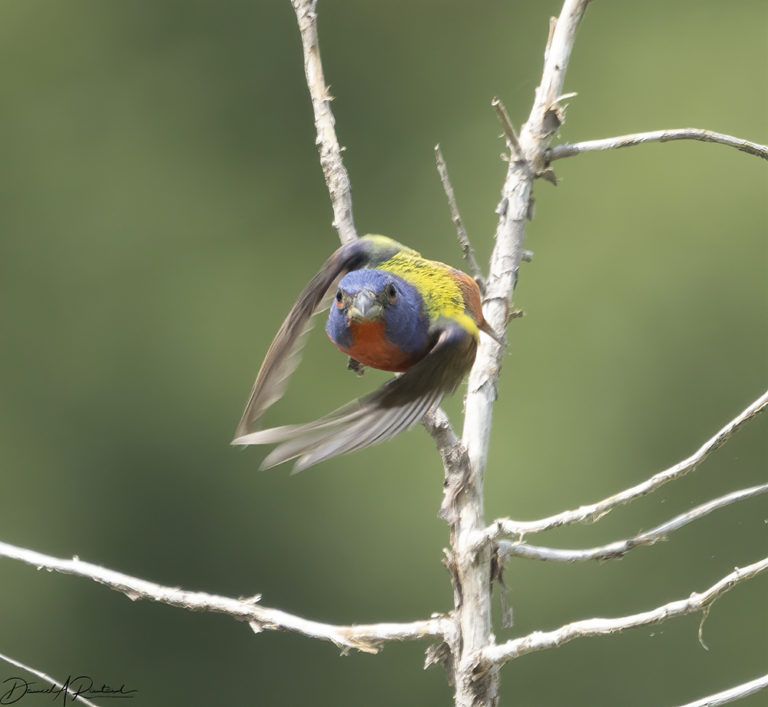
Another more classically-attired male Painted Bunting, in flight and seemingly with a purpose.

eclare
Great photos and information! The baby Scissor-tail Flycatcher is adorbs.
Mary G
I love all the Buntings.
Rob
The Red-headed Woodpecker shot is wonderful. I saw and heard one on Saturday here in Maryland but the view was distant and backlit so it is nice to see this photo.
OzarkHillbilly
I have yet to see a Painted Bunting. Not particularly surprising considering that most of my travels into their breeding range during summer has inevitably involved long periods underground with anytime above ground spent in the water so as to keep cool. Still, I feel cheated.
Anonymous At Work
Owl, “You’re going to take my picture with *that* camera? Can’t you afford a decent rig, grandpa?”
AM in NC
These are spectacular. Thank you so much for sharing!
JanieM
I wish I had you to give me all the bird gossip in my neighborhood!
Beautiful shots and a great way to start the day.
Chat Noir
Gorgeous photos!
WaterGirl
They are spectacular!
Love the owl and the Lark Sparrow.
The Indigo Bunting has such an amazing color. Is it just me, or is he giving me the side-eye? Note to self: do not piss off the indigo bunting.
What a great set to start the week.
Kattails
The owl was LOL for me, luckily I didn’t have a mouthful of coffee. All wonderful shots as usual, you are a master of this. The flycatchers in action is quite a composition!
mvr
These are all great photos, as usual. The woodpecker in flight chasing bugs is pretty unusual though.
Your comments about the young flycatcher confirmed something that surprised me when I saw it in my own backyard. Many of the birds that are young but old enough to fly seem still to need their parents to help them feed. Yesterday I saw a young bluejay, at least as large as its parent, chase the adult to try to get it to give it the sunflower seed it had in its mouth. And yet it was in the middle of a bunch of similar seeds lying at its feet. That’s where the one in its parent’s mouth had come from.
J R in WV
Wow, what a great set of bird pictures. Can’t pic a favorite. Love the red-head woodpecker eating while flying… dinosaurs can be adaptable. We have lots of Pileated woodpeckers locally, they scream in the woods.
Thanks for sharing, as always!
NetheadJay
Man, I would not get in the way of that last Painted Bunting, he looks pissed about something.
And that’s a very nice action shot of the Scissor-tailed Flycatchers “discussing property lines (LOL). Contrast that with the bedhead Great Horned just sitting there, don’t think anybody’s about to discuss anything with that dude, sleepy eyes or not.
opiejeanne
Wow! Brilliant photos. The scissor tails and buntings just can’t be real birds, they’re too fantastic; like illustrations in a fairy tale. Thank you so much for sharing.
40 years ago we parked our camper in a spot under a big tree, in Liberal, Kansas, a misnamed place if ever there was one. It was about 6pm on a Sunday, our food supply was low, and we had trouble finding anything open so we could have supper. I think we found a McDonald’s. We had to feed quarters into the meter to keep the water on in the shower because the timer cheated a little, went to bed a bit grumpy, and at OhGawdWhatTimeIsIt??? were awoken by an incredible cacophony. Birds. Hundreds of dickcissels in the tree over the camper, chirping their happy brains out. At least that’s what the owner of the campground told us they were. He called them dickie birds.
That was an interesting trip, bird-wise. In a Missouri park, a cuckoo flew up to a wire fence, to have a look at us. We didn’t know what on earth it was, so we bought our first bird book, the Roger Tory Peterson. That book was loved to death.
way2blue
Your photo of the Red-headed Woodpecker looks so much like an Audubon print to me. The Scissor-tailed Flycatcher one too. Amazing compositions. And. I’d never thought about how birds make feathers, let alone, yearly. Quite a trick. Thanks for introducing me to the diverse birds tucked into your neighborhood. So different to mine.
4D*hiker
Interesting information about the Painted Bunting’s immature plumage. I’m very familiar with their call, but sometimes couldn’t spot their colorful plumage. Now I know why. Thanks!
StringOnAStick
I love all your photos, such a pleasure to see.
The CA quail showed up last night in early dusk, first a group of 6 adults with 6 half grown chicks, then another group of 9 came into the yard from the other side. There was one male who appeared to take his watchbird role very seriously while the rest scratched for food. I love how they straighten to vertical to run, and are really fast when they do.
Albatrossity
Thanks, all. I was AWOL this morning because I was out birding and had to drive a bit to get there, and back. I’m glad that you all like to start Mondays with bird pics!